Abstract
Background
Endoscopic ultrasound-guided liver biopsy (EUS-LB) has emerged as a viable mean to obtain core tissue, but the optimal tools and techniques are still an area of active investigation.
Aims
(1) To compare tissue adequacy using “wet saline” (WS) vs. “wet heparin” (WH) technique (2) To compare post-procedure pain between EUS-LB and percutaneous liver biopsy (PLB).
Methods
Retrospective review of consecutive patients who underwent EUS-LB and PLB for benign parenchymal liver disease between May 2017 to October 2019 at a single tertiary veterans affairs medical center.
Results
About 257 biopsies from 217 patients were included. Among the 102 EUS-LB specimens, 53 were obtained using WS technique and 49 were obtained using WH technique. Specimen adequacy was similar in both groups. Median Aggregate Specimen Length (ASL) and length of longest piece did not differ significantly between WS and WH groups. Clots were present more frequently in the WS group. Among patients who underwent EUS-LB of both right and left liver lobes, an adequate biopsy was obtained in 85% of patients in the WS group and 96% of patients in the WH group. The percentage of patients experiencing immediate post-procedure pain was higher with PLB compared to EUS-LB, but these results were not statistically significant.
Conclusions
Both WS and WH EUS-LB techniques can offer high rates of specimen adequacy with low rates of pain and other post-procedure complications.
Similar content being viewed by others
References
Rockey DC, Caldwell SH, Goodman ZD, Nelson RC, Smith AD. Diseases AAftSoL. Liver biopsy. Hepatology. 2009;49:1017–1044.
Nalbantoglu IL, Brunt EM. Role of liver biopsy in nonalcoholic fatty liver disease. World J Gastroenterol. 2014;20:9026–9037.
Castéra L, Nègre I, Samii K, Buffet C. Patient-administered nitrous oxide/oxygen inhalation provides safe and effective analgesia for percutaneous liver biopsy: a randomized placebo-controlled trial. Am J Gastroenterol. 2001;96:1553–1557.
Meng HC, Lin HC, Huang CC et al. Transjugular liver biopsy: comparison with percutaneous liver biopsy. J Gastroenterol Hepatol. 1994;9:457–461.
Diehl DL, Johal AS, Khara HS et al. Endoscopic ultrasound-guided liver biopsy: a multicenter experience. Endosc Int Open. 2015;3:E210-215.
Mohan BP, Shakhatreh M, Garg R, Ponnada S, Adler DG. Efficacy and safety of EUS-guided liver biopsy: a systematic review and meta-analysis. Gastrointest Endosc. 2019;89:238-246.e233.
Attam R, Arain MA, Bloechl SJ et al. “Wet suction technique (WEST)”: a novel way to enhance the quality of EUS-FNA aspirate. Results of a prospective, single-blind, randomized, controlled trial using a 22-gauge needle for EUS-FNA of solid lesions. Gastrointest Endosc. 2015;81:1401–1407.
Kleiner DE, Brunt EM, Van Natta M et al. Design and validation of a histological scoring system for nonalcoholic fatty liver disease. Hepatology. 2005;41:1313–1321.
Bedossa P. Histological Assessment of NAFLD. Dig Dis Sci. 2016;61:1348–1355.
https://www.sealedenvelope.com/power/binary-superiority/ . https://www.sealedenvelope.com/power/binary-superiority/ . Accessed.
Nieto J, Dawod E, Deshmukh A, Penn E, Adler D, Saab S. EUS-guided fine-needle core liver biopsy with a modified one-pass, one-actuation wet suction technique comparing two types of EUS core needles. Endosc Int Open. 2020;8:E938–E943.
Hasan MK, Kadkhodayan K, Idrisov E et al. Endoscopic ultrasound-guided liver biopsy using a 22-G fine needle biopsy needle: a prospective study. Endoscopy. 2019;51:818–824.
Ali AH, Panchal S, Rao DS et al. The efficacy and safety of endoscopic ultrasound-guided liver biopsy versus percutaneous liver biopsy in patients with chronic liver disease: a retrospective single-center study. J Ultrasound. 2020;23:157–167.
Author information
Authors and Affiliations
Corresponding author
Ethics declarations
Conflict of interest
No conflict of interest.
Additional information
Publisher's Note
Springer Nature remains neutral with regard to jurisdictional claims in published maps and institutional affiliations.
Rights and permissions
About this article
Cite this article
Saraireh, H., Abdelfattah, T., Hassouneh, R. et al. “Wet Heparin” and “Wet Saline” EUS-Guided Liver Biopsy Techniques Both Provide High Rates of Specimen Adequacy for Benign Parenchymal Liver Disease. Dig Dis Sci 67, 5256–5261 (2022). https://doi.org/10.1007/s10620-022-07399-7
Received:
Accepted:
Published:
Issue Date:
DOI: https://doi.org/10.1007/s10620-022-07399-7




